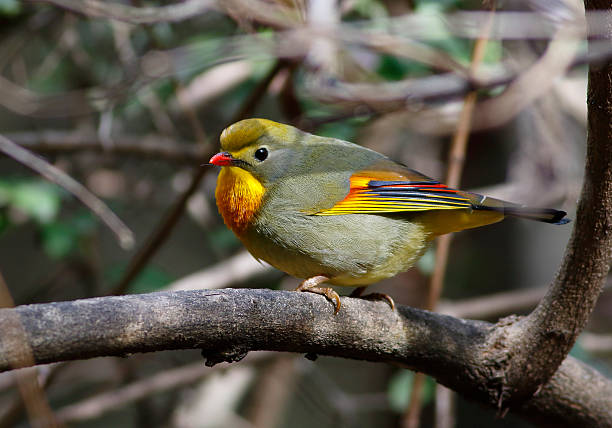ANIMAL: Red-Billed Leiothrix/Pekin Robin Leiothrix lutea Type of Animal: Songbird Habitat: Underbrush, forest, forest edge, mountainside forest clearings, woodland, dense thickets, plantations, scrub, gardens, shrubland, bramble areas near streams, vegetated areas near abandoned buildings, woodland-farmland mosaic, farms Location(s): Native to S & E China, N India, Nepal, Bhutan, Burma, N Indochina, & NE Pakistan. Introduced in Japan, Hawaii, Reunion, & W Europe. Appearance: Small bird w/ bright red bill, olive green body, bright yellow-orange throat, yellow chin, & dull yellow eye ring. Wing feather edges brightly colored w/ yellow/orange/red/black. Bluish gray cheeks/neck sides. Males somewhat more colorful than females, though both sexes have fairly similar coloration. Males have more red markings. Both sexes have olive-brown forked tails w/ blackish tips. Younger birds have black bills. Food/Diet: Insects, insect larvae, berries, fruits, vegetables, leafy greens, spiders, nectar, seeds, grains, millipedes, snails, slugs Status in Wild: Stable Conservation: Breeding in zoos, wildlife centers, & aviculture Lifestyle: Flocks of 2-30 birds Additional Info: Called: Male: Cock Female: Hen Young: Chick Group: Flock Weight: Male: 0.91 oz Female: 0.77 oz Gestation: 2 weeks Life Span: 5 years in wild, 10-20 years in captivity Height: 5.5-6 in, same for both sexes Body Length: 5.5-6 in, same for both sexes Tail Length: 0.5 in, same for both sexes Main predators are rats, cats, snakes, & raptors. These birds are very active & rather secretive. Some captive birds are bolder. Open cup nesters w/ nests composed of dry leaves/moss/lichen. Males emit loud musical songs w/ alternating high & low notes, especially during breeding season. Some males may start singing as early as 5 weeks old. Maturity reached at 9-12 months old, Chicks fledge at 4-5 weeks but may stay w/ parents for another 1-1.5 months. Females lay 3-4 eggs per brood & can have as many as 7 broods per year. Fun Fact(s): In Europe, they compete w/ European Robins, Common/Eurasian Blackbirds, & Eurasian Blackcaps. While native birds typically much more aggressive than this nonnative species, these birds breed in higher densities & are even more prolific. These birds also called Chinese Nightingale, Japanese Nightingale, Pekin Nightingale, Japanese Robin, Japanese Hill Robin, Hill Tit, Red-Billed Mesia, Doubtful Leiothrix, & Red-Billed Robin. These birds only introduced to Japan in 1980s but have become quite established there. These birds have negative impact in Hawaii since they’re known vectors of avian malaria (a threat to many Hawaiian native songbirds) & disperse seeds of invasive plants. They sometimes compete w/ native birds as well. 1st introduced to Hawaii in 1910s. These birds popular cagebirds due to song, coloration, activity, & long lifespan. Introduced birds derive from escaped cagebirds.
